10 Km
Type of resources
Available actions
Topics
Keywords
Contact for the resource
Provided by
Years
Formats
Representation types
Update frequencies
status
Resolution
-
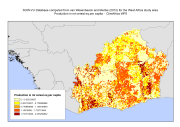
SOW-VU "Africa in maps" database updated from van Wesenbeeck and Merbis, 2012. These include population maps (total, urban, rural, refugees/IDPs), food aid distribution, and estimates of total production measured in mt cereal equivalents per capita. This data set have been used to complement the survey data and included in the "Climate change predictions in Sub-Saharan Africa: impacts and adaptations (ClimAfrica)" project, Work Package 5 (WP5). More information on ClimAfrica project is provided in the Supplemental Information section of this metadata. The study in WP5 aimed to identify, locate and characterize groups that are vulnerable for climate change conditions in two country clusters; one in West Africa (Benin, Burkina Faso, Côte d'Ivoire, Ghana, and Togo) and one in East Africa (Sudan, South Sudan and Uganda). Data used for the study include the Demographic and Health Surveys (DHS) , the Multi Indicator Cluster Survey (MICS) and the Afrobarometer surveys for the socio-economic variables and grid level data on agro-ecological and climatic conditions.
-
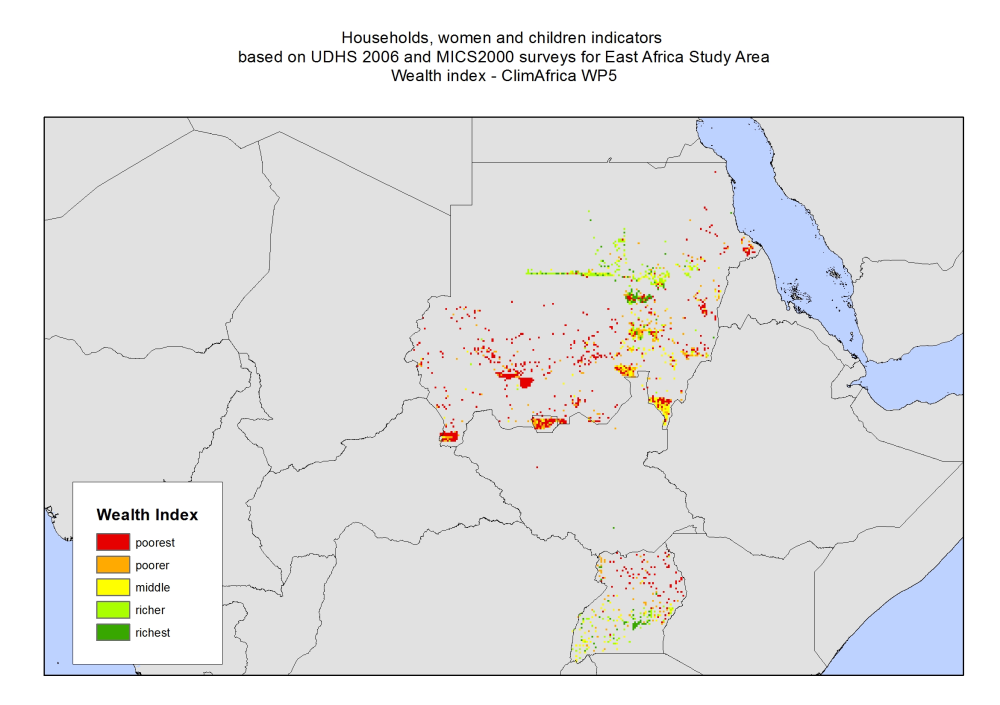
Households, women and children indicators based on the 2000 Sudan Multiple Indicator Cluster Survey (MICS2) and the Uganda Demographic and Health Survey (UDHS) 2006. DHS surveys are nationally representative household surveys that provide data for a wide range of indicators in the areas of population, health, and nutrition. Standard DHS surveys have large sample sizes (usually between 5,000 and 30,000 households) and are typically conducted about every 5 years, to allow comparisons over time. Multiple Indicator Cluster Survey (MICS) is an international household survey program developed by UNICEF. MICS data are collected during face-to-face interviews in nationally representative samples of households, generating one of the world's largest sources of statistical information on children and women. Since no DHS survey is available for Sudan and South Sudan, MICS surveys for 2000 for Sudan and South Sudan are used instead. The following indicators have been considered to create raster datasets at 5 arcmin resolution for Sudan, South Sudan and Uganda: wealth index, age and sex of the head of household, number of dependent household members (under the age of 5), educational attainment of the respondent, occupation of the respondent, current employment status of the respondent, type and duration employment of the respondent, payment received for work by the respondent, number of sons and daughters away from home, number of years the respondent lived in the current residence, religion of the respondent. This data set has been produced in the framework of the "Climate change predictions in Sub-Saharan Africa: impacts and adaptations (ClimAfrica)" project, Work Package 5 (WP5). More information on ClimAfrica project is provided in the Supplemental Information section of this metadata. This study in WP5 aimed to identify, locate and characterize groups that are vulnerable for climate change conditions in two country clusters; one in West Africa (Benin, Burkina Faso, Côte d'Ivoire, Ghana, and Togo) and one in East Africa (Sudan, South Sudan and Uganda). Data used for the study include the Demographic and Health Surveys (DHS) , the Multi Indicator Cluster Survey (MICS) and the Afrobarometer surveys for the socio-economic variables and grid level data on agro-ecological and climatic conditions.
-
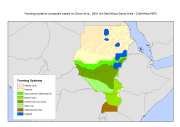
A farming system is defined as a population of individual farm systems that have broadly similar resource bases, enterprise patterns, household livelihoods and constraints, and for which related development strategies and interventions would be appropriate. Depending on the scale of the analysis, a farming system can encompass a few dozen or many millions of households. The map that is used in this exercise was presented in Dixon et al., 2001. The farming systems for Africa and their encoding are presented below: Code - Farming system 1 - Irrigated 2 - Tree crop 3 - Forest based 4 - Rice-tree crop 5 - Highland perennial 6 - Highland temperate mixed 7 - Root crop 8 - Cereal-root crop mixed 9 - Maize mixed 10 - Large commercial & smallholder 11 - Agro-pastoral millet/sorghum 12 - Pastoral 13 - Sparse (arid) 14 - Coastal artisanal fishing This dataset has been used to complement the survey data and included in the "Climate change predictions in Sub-Saharan Africa: impacts and adaptations (ClimAfrica)" project, Work Package 5 (WP5). More information on ClimAfrica project is provided in the Supplemental Information section of this metadata. This study in WP5 aimed to identify, locate and characterize groups that are vulnerable for climate change conditions in two country clusters; one in West Africa (Benin, Burkina Faso, Côte d’Ivoire, Ghana, and Togo) and one in East Africa (Sudan, South Sudan and Uganda). Data used for the study include the Demographic and Health Surveys (DHS) , the Multi Indicator Cluster Survey (MICS) and the Afrobarometer surveys for the socio-economic variables and grid level data on agro-ecological and climatic conditions.
-
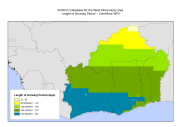
The Length of Growing Period (LGP) refers to the average duration when moisture availability allows crop growth. The calculation is based on a water balance model that compares moisture supply from precipitation, soil moisture storage and a reference evapotranspiration. The reference LGP assumes available soil moisture capacity of 100 mm per meter soil depth and a reference soil depth of one meter. LGP's were based on the baseline period of 1961-1990. This dataset has been used to complement the survey data and included in the "Climate change predictions in Sub-Saharan Africa: impacts and adaptations (ClimAfrica)" project, Work Package 5 (WP5). More information on ClimAfrica project is provided in the Supplemental Information section of this metadata. This study in WP5 aimed to identify, locate and characterize groups that are vulnerable for climate change conditions in two country clusters; one in West Africa (Benin, Burkina Faso, Côte d'Ivoire, Ghana, and Togo) and one in East Africa (Sudan, South Sudan and Uganda). Data used for the study include the Demographic and Health Surveys (DHS) , the Multi Indicator Cluster Survey (MICS) and the Afrobarometer surveys for the socio-economic variables and grid level data on agro-ecological and climatic conditions.
-

The altitude in (m) refers to median elevation at 5 arc-min while the slope class dataset refers to the median terrain slope class. Both datasets derived from a 3 arc-sec sub-grid of the Shuttle Radar Topography Mission (SRTM, http://www2.jpl.nasa.gov/srtm/). These datasets have been used to complement the survey data and included in the "Climate change predictions in Sub-Saharan Africa: impacts and adaptations (ClimAfrica)" project, Work Package 5 (WP5). More information on ClimAfrica project is provided in the Supplemental Information section of this metadata. This study in WP5 aimed to identify, locate and characterize groups that are vulnerable for climate change conditions in two country clusters; one in West Africa (Benin, Burkina Faso, Côte d'Ivoire, Ghana, and Togo) and one in East Africa (Sudan, South Sudan and Uganda). Data used for the study include the Demographic and Health Surveys (DHS) , the Multi Indicator Cluster Survey (MICS) and the Afrobarometer surveys for the socio-economic variables and grid level data on agro-ecological and climatic conditions.
-
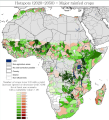
The hotspots zones of all the rainfed crops have been combined with the suitability classes as follow. The number of crops with a yield increase or decrease of more than 10 and 20% has been computed considering two suitability thresholds: one above 0% and another one above 40%. The results have been mapped showing the areas with positive impact in green and the areas with a negative impact in red. One map has been produced considering at least one scenario showing the same trend and the other one considering at least two scenarios showing the same trend. This data set has been produced in the framework of the “Climate change predictions in Sub-Saharan Africa: impacts and adaptations (ClimAfrica)” project, Work Package 4 (WP4). More information on ClimAfrica project is provided in the Supplemental Information section of this metadata.
-
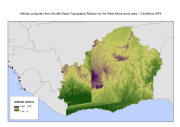
The altitude in (m) refers to median elevation at 5 arc-min while the slope class dataset refers to the median terrain slope class. Both datasets derived from a 3 arc-sec sub-grid of the Shuttle Radar Topography Mission (SRTM, http://www2.jpl.nasa.gov/srtm/). These datasets have been used to complement the survey data and included in the "Climate change predictions in Sub-Saharan Africa: impacts and adaptations (ClimAfrica)" project, Work Package 5 (WP5). More information on ClimAfrica project is provided in the Supplemental Information section of this metadata. This study in WP5 aimed to identify, locate and characterize groups that are vulnerable for climate change conditions in two country clusters; one in West Africa (Benin, Burkina Faso, Côte d'Ivoire, Ghana, and Togo) and one in East Africa (Sudan, South Sudan and Uganda). Data used for the study include the Demographic and Health Surveys (DHS) , the Multi Indicator Cluster Survey (MICS) and the Afrobarometer surveys for the socio-economic variables and grid level data on agro-ecological and climatic conditions.
-
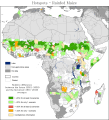
Hotspots zones have been identified for each agro-climatic and climatic parameter and future period, based on the yield anomaly classes (relative differences between the future and the historical period). For each crop and each period, the hotspots are represented by 5 classes: - Zones with a high decrease (>20%) for at least one scenario - Zones with a high decrease (>20%) for at least two scenarios - Zones with a high increase (>20%) for at least one scenario - Zones with a high increase (>20%) for at least two scenarios - Zones with a contradictory information between models This data set has been produced in the framework of the “Climate change predictions in Sub-Saharan Africa: impacts and adaptations (ClimAfrica)” project, Work Package 4 (WP4). More information on ClimAfrica project is provided in the Supplemental Information section of this metadata..
-
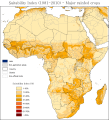
The suitability analysis allowed identifying a suitability index combining the suitability weights (combination of soil and climate) of the twelve major crops for the historical period (1981-2010). This data set has been produced in the framework of the “Climate change predictions in Sub-Saharan Africa: impacts and adaptations (ClimAfrica)” project, Work Package 4 (WP4). More information on ClimAfrica project is provided in the Supplemental Information section of this metadata.
-
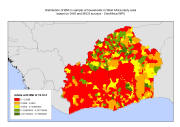
Vulnerable population identified by the nutritional status of women (BMI) as indicator for food security, in sample of households in West Africa study area. Data based on DHS and MICS surveys. In defining vulnerability, WFP (2009) and IFPRI (2012) have been followed and combined with indicators for food security with health indicators that signal vulnerability in a physical sense. IFPRI's Global Hunger Index uses three indicators to measure hunger: the number of adults being undernourished, the number of children that have low weight for age, and child mortality. Other classifications of food security use the variety of the diet as an indicator, combined with anthropometric data on children. However, in the DHS data there were no information available on child mortality, nor on dietary composition. Given these data limitations, data on nutritional status of women (Body Mass Index, BMI) for women and children (weight for age) have been used as indicators for food security. These data were combined with data on morbidity among adults and children, specifically the occurrence of malaria, cough, and diarrhea. Combinations of indicators have led to a classification of households as being very vulnerable, vulnerable, nearly vulnerable and not vulnerable. This data set was produced in the framework of the "Climate change predictions in Sub-Saharan Africa: impacts and adaptations (ClimAfrica)"project, Work Package 5 (WP5). More information on ClimAfrica project is provided in the Supplemental Information section of this metadata. This study in WP5 aimed to identify, locate and characterize groups that are vulnerable for climate change conditions in two country clusters; one in West Africa (Benin, Burkina Faso, Côte d'Ivoire, Ghana, and Togo) and one in East Africa (Sudan, South Sudan and Uganda). Data used for the study include the Demographic and Health Surveys (DHS) , the Multi Indicator Cluster Survey (MICS) and the Afrobarometer surveys for the socio-economic variables and grid level data on agro-ecological and climatic conditions.
 FAO Map Catalog
FAO Map Catalog